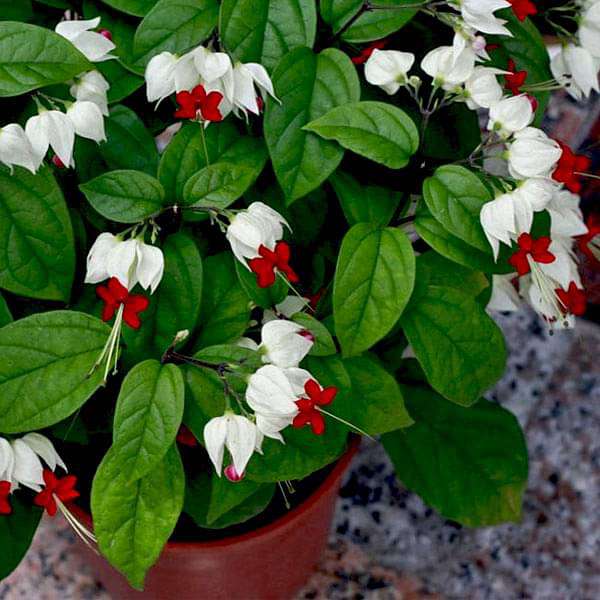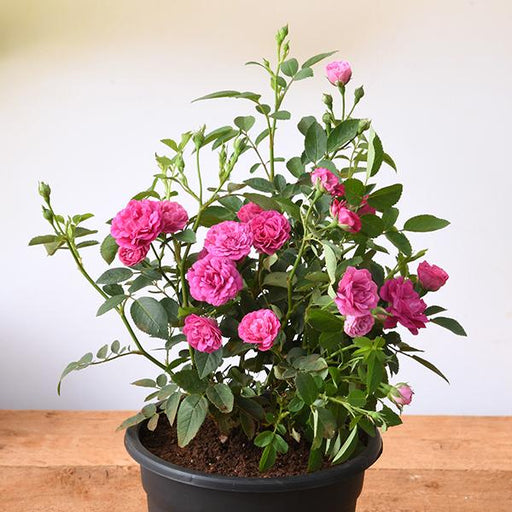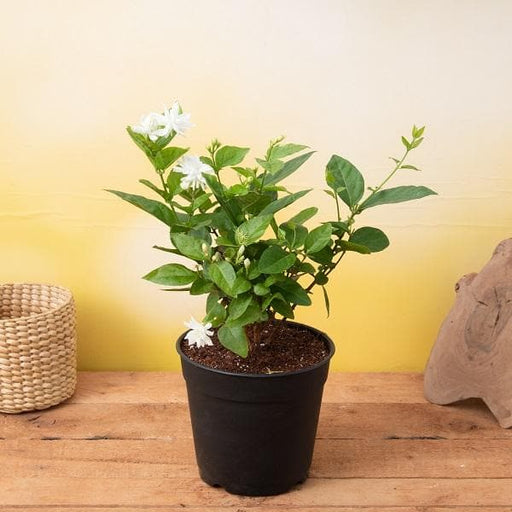
Bleeding Heart Vine, Clerodendrum thomsoniae - Plant
(MRP Inclusive of all taxes)
- Shipping ₹79 for entire order
- Dispatch in 7 days
- Country of origin: India

(MRP Inclusive of all taxes)
 Save 29%
Save 29%
Air Purifier Money Plant with Pot The Air Purifier Money Plant, also known as Pothos or Epipremnum aureum, is a stunning indoor plant that...
View full details
 Save up to 15%
Save up to 15%
Peace Lily, Spathiphyllum - Plant The Peace Lily, scientifically known as Spathiphyllum, is a stunning houseplant celebrated for its elegant white...
View full details
 Save 25%
Save 25%
Jasminum sambac, Mogra, Arabian Jasmine - Plant Jasminum sambac, commonly known as Mogra or Arabian Jasmine, is a fragrant flowering plant...
View full details
 Save 18%
Save 18%
Combo Constituents Includes the Parijat Tree (Night-Flowering Jasmine), a culturally significant plant with fragrant flowers. Description The Pari...
View full details
 Save 25%
Save 25%
Miniature Rose, Button Rose (Any Color) - Plant The Miniature Rose, also known as the Button Rose, is a charming and compact flowering plant that ...
View full details Save 25%
Save 25%
Damascus Rose, Scented Rose (Any Color) - Plant The Damascus Rose, also known as Rosa damascena, is a timeless symbol of beauty and romanc...
View full details
 Save 17%
Save 17%
Beautiful Fragrant Mogra, Arabian Jasmine Plant with Pot The Beautiful Fragrant Mogra, also known as Arabian Jasmine (Jasminum sambac), is...
View full details Save 15%
Save 15%
Pack of Vermicompost and Neem Cake for House Plants Transform your indoor garden with our premium Pack of Vermicompost and Neem Cake, spec...
View full details
Pack of Plant Growth and Flower Boosters Unlock the full potential of your garden with our Pack of Plant Growth and Flower Boosters! This ...
View full details Save 38%
Save 38%
Combo of Jeevamrut and Neem Raksha for Easy Growth and Protection of Houseplants Transform your indoor garden with our exclusive combo of ...
View full details Save 22%
Save 22%
Plant Nutrients Kit (Pack of 16) for a Healthy Garden Transform your garden into a lush paradise with our Plant Nutrients Kit, featuring 1...
View full details Save 16%
Save 16%
Combo of Top Plant Fertilizers Elevate your gardening game with our exclusive Combo of Top Plant Fertilizers, featuring two bags of premiu...
View full details Save 24%
Save 24%
Pack of 4 Additives to Make Soil Healthy and Nutrient Rich Transform your garden into a thriving ecosystem with our Pack of 4 Additives de...
View full details Save 30%
Save 30%
Transform your gardening experience with our premium Combo of Perlite and Vermiculite. This unique blend is designed to enhance soil aeration and ...
View full details Save 27%
Save 27%
Combo of 2 Vermicompost and Cocopeat - Enrich Your Soil Naturally! Transform your garden into a thriving ecosystem with our Combo of 2 Ver...
View full details
 Save 35%
Save 35%
Best 6 Plants for Perfect Indoor Garden Transform your living space into a lush oasis with our curated collection of the Best 6 Plants for a...
View full details
 Save up to 50%
Save up to 50%
Mini Succulent Garden Pack Transform your space with our Mini Succulent Garden Pack, featuring a delightful collection of 4 any variety beautiful s...
View full details
 Save 30%
Save 30%
5 Best Fragrant Plants Transform your garden or indoor space into a fragrant paradise with our curated selection of the 5 Best Fragrant Plants. Th...
View full details
 Save 24%
Save 24%
Set of 2 Bonsai Looking Grafted Adeniums Transform your indoor or outdoor space with our exquisite Set of 2 Bonsai Looking Grafted Adenium...
View full details Save 45%
Save 45%
Top 4 Die Hard Succulents Pack Transform your indoor or outdoor space with our Top 4 Die Hard Succulents Pack, featuring a curated selecti...
View full details
 Save 30%
Save 30%
5 Best Indoor Plants Pack Transform your living space into a lush oasis with our '5 Best Indoor Plants Pack.' This carefully curated collection fe...
View full details
 Save 25%
Save 25%
Set of 4 Evergreen Air Purifier Plant Pack Transform your indoor space into a lush, green oasis with our Set of 4 Evergreen Air Purifier Pla...
View full details| SrNo | Item Name | Qty |
|---|---|---|
| 2 | Bleeding Heart Vine, Clerodendrum thomsoniae Plant | 1 |
The Bleeding Heart Vine, scientifically known as Clerodendrum thomsoniae, is a stunning tropical plant renowned for its heart-shaped flowers that dangle like delicate ornaments. Native to West Africa, this perennial vine can reach up to 10 feet in length, making it an excellent choice for trellises, arbors, or hanging baskets. Its vibrant red and white blooms create a striking contrast, attracting pollinators and adding a touch of exotic beauty to any garden or indoor space.
What makes the Bleeding Heart Vine truly special is its unique flower structure, which resembles a bleeding heart, symbolizing love and compassion. This plant not only enhances the aesthetic appeal of your surroundings but also serves as a conversation starter, making it a favorite among gardeners and plant enthusiasts alike. Its ability to thrive in various conditions adds to its charm, making it a versatile addition to any collection.
One of the standout features of Clerodendrum thomsoniae is its rapid growth rate and resilience. This vine can flourish in both indoor and outdoor settings, providing lush greenery and vibrant blooms throughout the growing season. Its adaptability to different light conditions and soil types makes it an ideal choice for both novice and experienced gardeners.
If you think caring for a Bleeding Heart Vine is like a walk in the park, think again! This tropical beauty demands attention, but don’t worry, it’s not high maintenance—just a bit of a diva. Keep it in bright, indirect sunlight, and it will reward you with stunning heart-shaped flowers that could make Cupid jealous. Water it regularly, but don’t drown it; this plant prefers to sip rather than gulp. Fertilize during the growing season, and watch it flourish like a starlet on the red carpet.
Watching your Clerodendrum Thomsoniae grow is like witnessing a romantic comedy unfold. It starts as a modest little vine, but with the right care, it transforms into a lush, cascading spectacle. This plant can reach heights of up to 10 feet, so be prepared for a love affair that’s hard to contain. Prune it back to keep it in check, or let it roam free like a wild heart in search of adventure.
Propagating your Bleeding Heart Vine is like matchmaking for plants. You can take cuttings and watch them root, creating new little love stories in your garden. Just snip a healthy stem, pop it in water or soil, and give it some TLC. Before you know it, you’ll have a whole family of Bleeding Heart Vines, each one ready to steal the show with its charming blooms.
Every romance has its challenges, and for the Bleeding Heart Vine, pests are the villains. Aphids and spider mites may try to crash the party, but fear not! A gentle spray of insecticidal soap or neem oil can send them packing. Keep an eye out for these uninvited guests, and your vine will continue to thrive, basking in the glory of its floral fame.
The secret to a happy Bleeding Heart Vine lies in its soil. Think of it as the perfect date night—well-draining, rich in organic matter, and slightly acidic. A mix of potting soil and perlite will do the trick, allowing roots to breathe while soaking up nutrients. Avoid heavy clay soils that can suffocate your vine’s dreams of grandeur.
Sunlight is the lifeblood of your Clerodendrum Thomsoniae, but it’s a bit of a Goldilocks when it comes to brightness. Too much direct sun, and it might get scorched; too little, and it’ll sulk in the shadows. Aim for bright, indirect light, and your vine will bloom like it’s auditioning for a leading role in a botanical blockbuster.
Fertilizing your Bleeding Heart Vine is like giving it a pep talk before a big performance. During the growing season, a balanced liquid fertilizer will boost its confidence and encourage those stunning blooms. Just remember, too much of a good thing can lead to a dramatic flop, so stick to a schedule and watch your vine shine.
The flowering season of Clerodendrum Thomsoniae is like the grand finale of a fireworks show. Typically, it bursts into bloom in late spring to early summer, showcasing its heart-shaped flowers that are sure to steal the spotlight. With the right care, you’ll have a front-row seat to this floral extravaganza, making your garden the talk of the town.
While the Bleeding Heart Vine is a showstopper, it’s important to know that it’s not a snack for pets or humans. Its leaves contain compounds that can be toxic if ingested, so keep it out of reach of curious critters. Think of it as the mysterious, alluring character in a novel—beautiful but best admired from a distance.
Growing Clerodendrum Thomsoniae indoors is like hosting a fabulous party in your living room. It thrives in bright, indirect light and loves humidity, so consider misting it or placing it near a humidifier. With the right conditions, your indoor vine will become the life of the party, filling your space with vibrant blooms and a touch of tropical flair.
Planting your Bleeding Heart Vine outdoors is like sending it off to summer camp—exciting and a little nerve-wracking! Choose a spot with well-draining soil and plenty of sunlight, and watch it take off. Just be sure to provide a trellis or support for it to climb, and soon you’ll have a stunning display that will make your neighbors green with envy.
Pairing your Clerodendrum Thomsoniae with the right companion plants is like finding the perfect sidekick in a buddy movie. Consider planting it alongside ferns or other tropical plants that enjoy similar conditions. This dynamic duo will create a lush, vibrant garden that’s bursting with life, making every day feel like a tropical getaway.
Ah, the Bleeding Heart Vine! This tropical beauty is a climbing plant known for its heart-shaped flowers that look like they’re dripping with color. Native to West Africa, it’s a showstopper in gardens and a favorite for hanging baskets. Just be careful—its charm can make you forget about your other plants!
Caring for your Bleeding Heart Vine is like nurturing a diva. It loves bright, indirect sunlight and moist, well-draining soil. Keep it warm and humid, and don’t forget to give it a little fertilizer during the growing season. Just remember, too much water can lead to a sad, droopy vine!
Absolutely! The Bleeding Heart Vine is a perfect indoor companion, as long as you provide it with enough light and humidity. Place it near a bright window, and it’ll reward you with stunning blooms. Just be prepared for it to climb your curtains if it gets too ambitious!
Your Bleeding Heart Vine craves well-draining soil that’s rich in organic matter. A mix of potting soil and perlite or sand will do the trick. Think of it as giving your plant a luxurious spa treatment—because who doesn’t want to feel pampered while growing those gorgeous flowers
Water your Bleeding Heart Vine when the top inch of soil feels dry. It’s like giving it a refreshing drink after a long day. Just avoid drowning it; soggy roots are a recipe for disaster. Remember, moderation is key—your plant doesn’t want to swim, just sip!
Yes, indeed! The Bleeding Heart Vine is a natural climber and loves to scale trellises, fences, or even your neighbor’s garden gnome. Provide it with a sturdy support structure, and watch it twirl and twist its way to the top. It’s like a botanical version of a rock climber!
Good news for pet parents! The Bleeding Heart Vine is considered non-toxic to cats and dogs. However, it’s always wise to keep an eye on your furry friends, as they might still find the leaves tempting. Better safe than sorry—no one wants a plant party gone wrong!
Your Bleeding Heart Vine will typically bloom from late spring to early fall, showering you with its heart-shaped flowers. It’s like a floral fireworks show, brightening up your garden. Just be patient; good things come to those who wait, and this vine knows how to make an entrance!
Absolutely! Propagating your Bleeding Heart Vine is as easy as pie. Simply take cuttings from healthy stems, place them in water or moist soil, and watch them root. It’s like cloning your favorite plant—just don’t expect them to have the same personality!
Keep an eye out for aphids, spider mites, and mealybugs—those pesky little critters love to crash the party. Regularly inspect your plant and give it a gentle wash to keep pests at bay. A little vigilance goes a long way in ensuring your vine stays fabulous!
With proper care, your Bleeding Heart Vine can live for several years, becoming a cherished part of your plant family. Think of it as a long-term relationship; nurture it, and it’ll reward you with stunning blooms for seasons to come. Just remember, every plant needs a little love!
In cooler climates, the Bleeding Heart Vine may not survive the winter outdoors. It’s best to bring it inside or treat it as an annual. If you’re in a warmer zone, it might just keep on blooming. Either way, give it a cozy spot to hibernate, and it’ll thank you come spring!